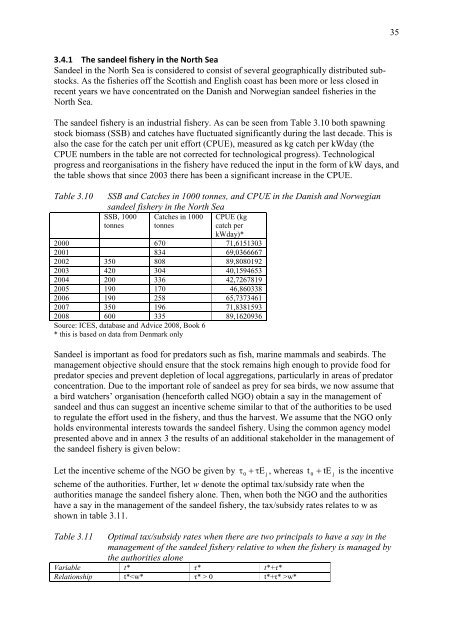Operational tools and adaptive management
Operational tools and adaptive management
Operational tools and adaptive management
You also want an ePaper? Increase the reach of your titles
YUMPU automatically turns print PDFs into web optimized ePapers that Google loves.
3.4.1 The s<strong>and</strong>eel fishery in the North Sea<br />
S<strong>and</strong>eel in the North Sea is considered to consist of several geographically distributed substocks.<br />
As the fisheries off the Scottish <strong>and</strong> English coast has been more or less closed in<br />
recent years we have concentrated on the Danish <strong>and</strong> Norwegian s<strong>and</strong>eel fisheries in the<br />
North Sea.<br />
The s<strong>and</strong>eel fishery is an industrial fishery. As can be seen from Table 3.10 both spawning<br />
stock biomass (SSB) <strong>and</strong> catches have fluctuated significantly during the last decade. This is<br />
also the case for the catch per unit effort (CPUE), measured as kg catch per kWday (the<br />
CPUE numbers in the table are not corrected for technological progress). Technological<br />
progress <strong>and</strong> reorganisations in the fishery have reduced the input in the form of kW days, <strong>and</strong><br />
the table shows that since 2003 there has been a significant increase in the CPUE.<br />
Table 3.10 SSB <strong>and</strong> Catches in 1000 tonnes, <strong>and</strong> CPUE in the Danish <strong>and</strong> Norwegian<br />
s<strong>and</strong>eel fishery in the North Sea<br />
SSB, 1000<br />
tonnes<br />
Catches in 1000<br />
tonnes<br />
CPUE (kg<br />
catch per<br />
kWday)*<br />
2000 670 71,6151303<br />
2001 834 69,0366667<br />
2002 350 808 89,8080192<br />
2003 420 304 40,1594653<br />
2004 200 336 42,7267819<br />
2005 190 170 46,860338<br />
2006 190 258 65,7373461<br />
2007 350 196 71,8381593<br />
2008 600 335 89,1620936<br />
Source: ICES, database <strong>and</strong> Advice 2008, Book 6<br />
* this is based on data from Denmark only<br />
S<strong>and</strong>eel is important as food for predators such as fish, marine mammals <strong>and</strong> seabirds. The<br />
<strong>management</strong> objective should ensure that the stock remains high enough to provide food for<br />
predator species <strong>and</strong> prevent depletion of local aggregations, particularly in areas of predator<br />
concentration. Due to the important role of s<strong>and</strong>eel as prey for sea birds, we now assume that<br />
a bird watchers‟ organisation (henceforth called NGO) obtain a say in the <strong>management</strong> of<br />
s<strong>and</strong>eel <strong>and</strong> thus can suggest an incentive scheme similar to that of the authorities to be used<br />
to regulate the effort used in the fishery, <strong>and</strong> thus the harvest. We assume that the NGO only<br />
holds environmental interests towards the s<strong>and</strong>eel fishery. Using the common agency model<br />
presented above <strong>and</strong> in annex 3 the results of an additional stakeholder in the <strong>management</strong> of<br />
the s<strong>and</strong>eel fishery is given below:<br />
Let the incentive scheme of the NGO be given by 0 E j , whereas t 0 tE j is the incentive<br />
scheme of the authorities. Further, let w denote the optimal tax/subsidy rate when the<br />
authorities manage the s<strong>and</strong>eel fishery alone. Then, when both the NGO <strong>and</strong> the authorities<br />
have a say in the <strong>management</strong> of the s<strong>and</strong>eel fishery, the tax/subsidy rates relates to w as<br />
shown in table 3.11.<br />
Table 3.11 Optimal tax/subsidy rates when there are two principals to have a say in the<br />
<strong>management</strong> of the s<strong>and</strong>eel fishery relative to when the fishery is managed by<br />
the authorities alone<br />
Variable t* τ* t*+τ*<br />
Relationship t* 0 t*+τ* >w*<br />
35

















